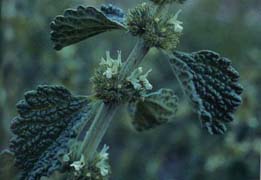The Photos in the monograph can only be seen if you open the attachment. You can however see my drawing. Sadly, if you are on a PC you will not be able to see the photos in the document. They can only be seen on a Mac. Sorry about that, but I use and own a Mac!
The monograph is copied and pasted here, but for best viewing please open the attached file. Thank you, Alina
Lemon Balm
Family Name: Mint
Family Name: Lamiaceae/Labiatae
Latin Name: Melissa offinalis
(Also Known As): Melissa
Common Names: Balm, Sweet Balm, Melissa, Garden-Balm, Sweet-Balm (2:12, 3:161)
Native American Names: none found
Related Species: Mint Family
Sitting With/Dreams/Sense of the Plant: I grow this at my mom’s house. It’s really yummy on fish.
Body System Affiliations:
1. Nervine
2. Skin
3. Digestive System
4. Urinary System
Botanical Description:
Habit: Herb - Perennial
Size: Medium
Arrangement: Opposite
Leaves: 1-3 inches long, medium green, bluntly toothed, round to somewhat triangular (3:161)
Flowers: Small, pale yellow. Flowers from May to August (2:12)
Fruit: ovary has 4 nutlets
Underground Parts: small fibrous roots
Personal Observation and Description: The leaves smell like lemon
Ecology:
Habitat: Thrives in well-drained soil, tolerates poor and sandy soils with full sun. Can also handle partial shade. Once established it is very drought tolerant (1: online)
Range: Central and Southern Europe, Western Asia and Northern Africa. Naturalized in Britain (5:online).
Native Where: Native to France (2:12)
Personal Observation of Locations Observed, Dates and Description of Plants: I’ve only seen it grown in people’s gardens. Usually in containers or beds.
Western (European-American) Uses/Relationships:
Food: Rather than cite sources, because recipes would be endless, I will tell you that lemon balm is often used to flavor foods, especially fish and meats. It is also good in many drinks as a garnish.
Lemon Balm is used in wine and cordials for its delicate aroma and flavor (2:191).
Materials/Technology: Sometimes used for potpourri (5:online)
Medicine:
Part Used: aerial parts
Medicinal Actions: anti-spasmodic, analgesic, anti-viral, anti-depressant, diaphoretic (2:12, 3:163)
Indications: stomach pains, emotional stress, fever, diarrhea, gas, herpes, menstrual cramps, anxiousness, depression, flu, common cold (3:163)
Body System Associations: nervine, skin, digestive system, urinary system
Constituents: Citral, citronellal, eugenol, acetate, geraniol, polyphenols, tannins, falconoid, rosemarinic acid, triterpenoids (3:163).
Applications: Tincture, infusion
Preparation: For Tincture: 1:5 parts (dry herb: 50% alcohol) (3:163)
For Infusion: Boil 32 parts water, remove from heat, then steep 1 part herb by weight for ½ to 1 hour. Strain, and then add extra water through herb in strainer until original 32 parts is reached (3:24).
Pharmacy: Tincture: ½-1 teaspoon in hot water
Infusion: 3-4 fluid ounces (3:163)
Other: Lemon Balm is thought to be especially helpful with Herpes cold sores (3:163).
Cautions: None Found
Indigenous and Non-Western Use/Significance/Relationships: None Found
Propagation:
Technique: Propagate by dividing the root mass. It can also be propagated from seed, but seeds are tiny and germination can be slow (1: online).
Timing: Divide in spring or autumn (5: online).
Personal Experience: none
Harvest:
Plant Part: Leaves
Season of Harvest: Should be collected prior to flowering (2:12).
Method of Harvest: Pick it, or cut it
Ecological Considerations of Harvest: none found
Cultural Considerations of Harvest: none found
Cautions: none found
Personal Experience (see below)
It’s an incredibly easy plant to grow.
Personal Experience:
Food: I love lemon balm on halibut with garlic. Just go pick a bunch and rip it up, throw it on the fish, add a bit of garlic. It’s good because garlic tends to over power food and makes it the only thing you taste but lemon balm is strong enough to work with the garlic. But I also squeeze a bunch of lemon juice over it too.
Medicine:
Part Used: tincture
Desired Medicinal Actions: anti-viral
Targeted Indications: common cold
Procurement:
Source Radience
Condition Tincture
Cost about $10
Application/Preparation/Pharmacy:
Applications Tea
Preparation Added 30-40 drops to hot water
Pharmacy I tried to take it several times a day
Reason/Purpose Help me sleep, and help my cold
Experience Made me wake up several times in the night from sweats. So I stopped taking it at night and started adding it to my tea in the morning and day
Cautions based on experience: It makes some people sweat
Other Notes of Interest: Balm or Melissa Tea: Lemon Balm was an ingredient in Paracelsus’ “elixir vitae” with which he hoped to “renovate man and render him next to immortal.” (2:167) Paracelsus was an alchemist in the 1500’s.
Cautions: Be careful if you are on a sedative, as lemon balm may make the sedative extra strong.
Drawings, Photographs or Pressings :
George Jansoone. Photo Taken on April 30, 2005. Wikipedia.com
Ursulas Garten Lizenz, Wikipedia.com
 Lemon Balm: Drawn by, Alina Kretz. 3/5/07
Lemon Balm: Drawn by, Alina Kretz. 3/5/07
References Cited:
1. Christman, Steve. Floridata: Melissa offinalis. Website. Updated 4-2-07. Online at http://www.floridata.com/ref/M/meli_off.cfm [1]. Visited 2-24-07.
2. Meyer, Joseph E. The Herbalist. United States: Clarence Meyer, 1975.
3. Moore, Michael. Medicinal Plants of the Pacific West. Santa Fe, New Mexico: Red Crane Books, 1993.
4. Wikipedia. Website. Online at Http://www.wikipedia.com [1]. Constantly updated. Visited 2-17-07
5. Author Unknown. Plants For a Future Website. Online at
http://www.pfaf.org/database/plants.php?Melissa+officinalis. Visited 2-26-07.
Alina Kretz - Healing Gardens - Winter Quarters - 2007
